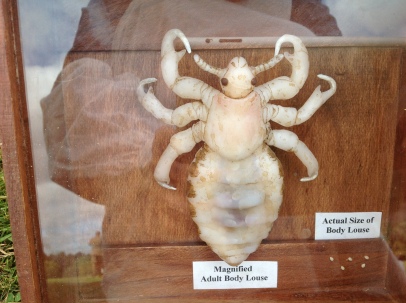
Our model of the human body louse
If your students are studying ‘Medicine Through Time’ and you’re focusing on WW1 medicine then this workshop is the perfect supplement to it. This workshop looks at the minor horrors of war such as rats, lice and flies, the diseases they caused (such as trench fever) and how they were treated. It also looks at trench foot, and gangrene. It covers war gases, the effect it had on the soldiers, the preventative measures such as gas masks and the cures. We also take a look at the evacuation pathway, showing how troops were brought home from the trenches. There is also time at the end to look at our various original artefacts such as the surgeons tools, prosthetic leg, VAD nurses wartime photo album, 100 year old wheel chair and much more.
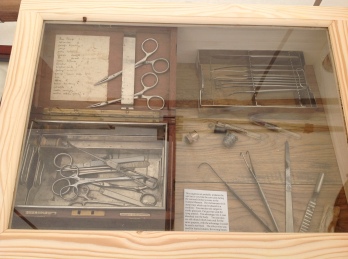
WW1 era surgeons tools including cat gut and silver wire.
Age group : GCSE
Display time: 45 mins to 1 hour (for a 45 min workshop we leave out the evacuation pathway).
Max number of students: 30 (or one class)
Number of displays per school day: Usually 4
Minimum number of teachers required: One
Display area: A large classroom. (A hall is preferable if available)
It is particularly suited to those who find it hard to study from textbooks or as a revision aid for those studying medicine for exams. It is designed to be fun and memorable.
Introduction
We introduce ourselves, Karen is dressed as a VAD (Voluntary Aid Detachment) nurse who were made up of St Johns Ambulance and the Red cross. VADs were mostly from upper class or middle class backgrounds and with very little training would be sent out the front to help assist the trained nurses and doctors. It was tough, dirty work and they did everything from nursing to ambulance driving. Wel is dressed as a WW1 sergeant, who is living through some of these terrible experiences and a dialogue opens up between the two characters throughout the workshop.
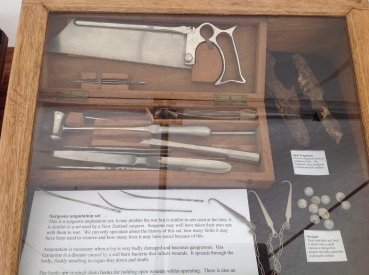
Amputation set, shrapnel and shell fragments
Minor horrors of war
We start by looking at the minor horrors of war, living in dirty holes in the ground, with little chance to wash or keep things clean lead to lots of health problems and some extra very much unwanted guests sharing the trenches with the soldiers. We look at the problem of lice and trench fever the disease it caused. We also look at rats and Weils disease. Flies and typhoid fever and briefly fleas and typhus.
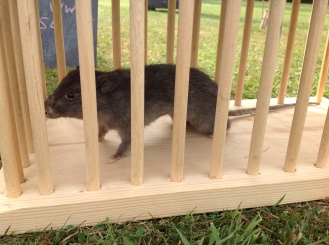
Taxidermy black rat
We also look at some of the other horrors faced in the trenches such as mud and water and the diseases they brought, gangrene and trench foot. We look at what caused the diseases, what the beliefs were at the time and how they tried to treat them. There is time at the end to view the amputation set, complete with saw, knifes, needles and retractors. We also have a WW1 era wooden peg leg which was found in the store room of an old WW1 hospital in France.

Original WW1 VADs photo album
Gas! Gas! Gas!
According to the Hague convention poison gas should never have been used as a weapon of war but regrettably was. We look at the different types of gas used, when they were introduced, and the masks and respirators which were brought in to use against them. We look at how the gases affected the soldiers, the symptoms of gas attack and how the nurses would have helped to make the soldiers better. We also look at gas fright, where soldiers were so terrified of being gassed that they developed symptoms of gas poisoning, even when they had not been gassed. We have a range of replica gas masks to show and talk about.
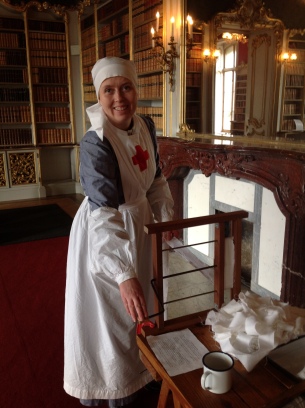
Karen as the VAD nurse in Wrest Park a real hospital during WW1. The library was one of the rooms used.
The Evacuation Pathway
Wel is the injured soldier and it is up to some of the students to carry Wel around through the different areas of the evacuation chain starting with the Regimental Aid post, through to the Field Ambulance, Casualty Clearing Station, ambulance train and so on, all the way back to Blighty. The pathway is presented in a fun and memorable way. With the use of props and changing signs.

You must be logged in to post a comment.